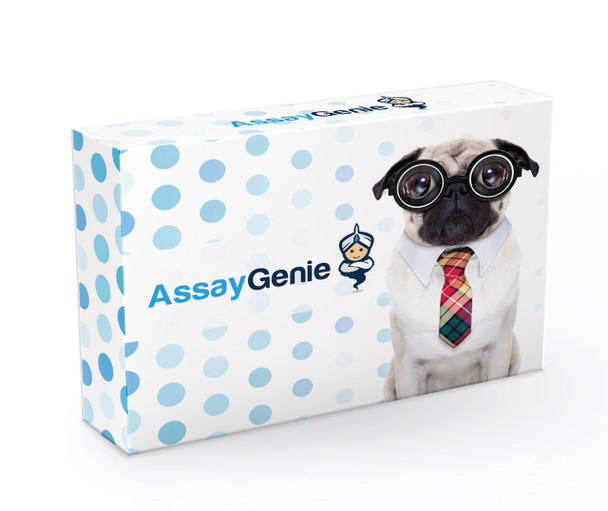Description
Rat CT1 (Cardiotrophin 1) ELISA Kit
The Rat CT1 (Cardiotrophin 1) ELISA Kit is specifically developed to quantitatively detect Cardiotrophin 1 levels in rat biological samples.
Cardiotrophin 1, a member of the interleukin-6 cytokine family, plays a critical role in various biological processes, including cardiovascular function and cell survival. Understanding the concentrations of Cardiotrophin 1 is essential for investigating its functions in cardiovascular health, tissue homeostasis, and disease conditions. This ELISA kit offers outstanding sensitivity and specificity, ensuring precise and reproducible results for your research needs. Manufactured under rigorous quality control standards, this kit provides reliable performance and user-friendly protocols, making it an excellent choice for elucidating the role of Cardiotrophin 1 in physiological and pathological contexts.
| Product Name: | Rat CT1 (Cardiotrophin 1) ELISA Kit |
| Product Code: | AEES00342 |
| Assay Type: | Sandwich |
| Format: | 96T |
| Assay Time: | 3.5h |
| Reactivity: | Rat |
| Detection Range: | 15.63-1000 pg/mL |
| Sensitivity: | 9.38 pg/mL |
| Sample Type & Sample Volume: | Serum, plasma and other biological fluids, 100μL |
| Specificity: | This kit recognizes Rat CT1 in samples. No significant cross-reactivity or interference between Rat CT1 and analogues was observed. |
| Reproducibility: | Both intra-CV and inter-CV are < 10%. |
| Application: | This ELISA kit applies to the in vitro quantitative determination of Rat CT1 concentrations in Serum, plasma and other biological fluids. |
This ELISA kit uses the Sandwich-ELISA principle. The micro ELISA plate provided in this kit has been pre-coated with an antibody specific to Rat CT1. Standards or samples are added to the micro ELISA plate wells and combined with the specific antibody. Then a biotinylated detection antibody specific for Rat CT1 and Avidin-Horseradish Peroxidase (HRP) conjugate are added successively to each micro plate well and incubated. Free components are washed away. The substrate solution is added to each well. Only those wells that contain Rat CT1, biotinylated detection antibody and Avidin-HRP conjugate will appear blue in color. The enzyme-substrate reaction is terminated by the addition of stop solution and the color turns yellow. The optical density (OD) is measured spectrophotometrically at a wavelength of 450 nm ± 2 nm. The OD value is proportional to the concentration of Rat CT1. You can calculate the concentration of Rat CT1 in the samples by comparing the OD of the samples to the standard curve.
Precision
Intra-assay Precision (Precision within an assay): 3 samples with low, mid range and high level Rat CT1 were tested 20 times on one plate, respectively.
Inter-assay Precision (Precision between assays): 3 samples with low, mid range and high level Rat CT1 were tested on 3 different plates, 20 replicates in each plate.
| Intra-assay Precision | Inter-assay Precision | |||||
| Sample | 1 | 2 | 3 | 1 | 2 | 3 |
| n | 20 | 20 | 20 | 20 | 20 | 20 |
| Mean (pg/mL) | 46.16 | 153.50 | 402.17 | 49.68 | 158.58 | 440.77 |
| Standard deviation | 3.08 | 8.37 | 15.89 | 3.10 | 9.36 | 15.07 |
| CV (%) | 6.67 | 5.45 | 3.95 | 6.24 | 5.90 | 3.42 |
Recovery
The recovery of Rat CT1 spiked at three different levels in samples throughout the range of the assay was evaluated in various matrices.
| Sample Type | Range (%) | Average Recovery (%) |
| Serum(n=8) | 88-100 | 93 |
| EDTA plasma (n=8) | 90-104 | 96 |
| Cell culture media (n=8) | 87-103 | 94 |
| Kit Components: | An unopened kit can be stored at 2-8℃ for 1 month. If the kit is not supposed to be used within 1 month, store the components separately according to the following conditions once the kit is received.
|
| 1. | Add 100μL standard or sample to the wells. Incubate for 90 min at 37°C |
| 2. | Discard the liquid, immediately add 100μL Biotinylated Detection Ab working solution to each well. Incubate for 60 min at 37°C |
| 3. | Aspirate and wash the plate for 3 times |
| 4. | Add 100μL HRP conjugate working solution. Incubate for 30 min at 37°C. Aspirate and wash the plate for 5 times |
| 5. | Add 90μL Substrate Reagent. Incubate for 15 min at 37°C |
| 6. | Add 50μL Stop Solution |
| 7. | Read the plate at 450nm immediately. Calculation of the results |






